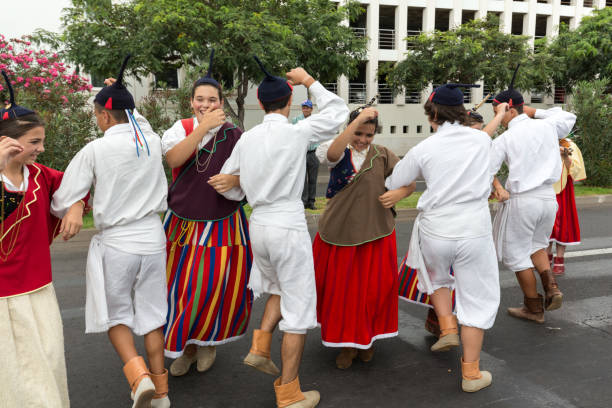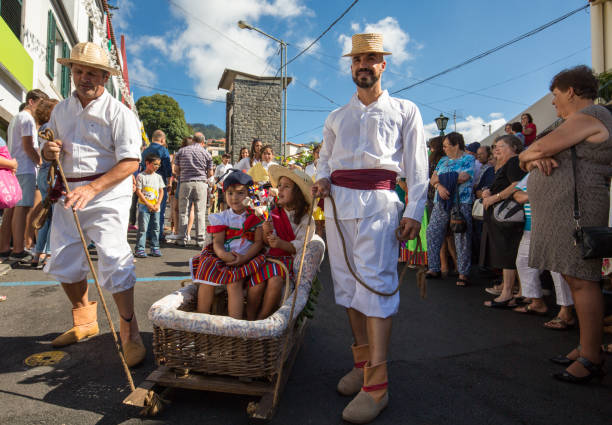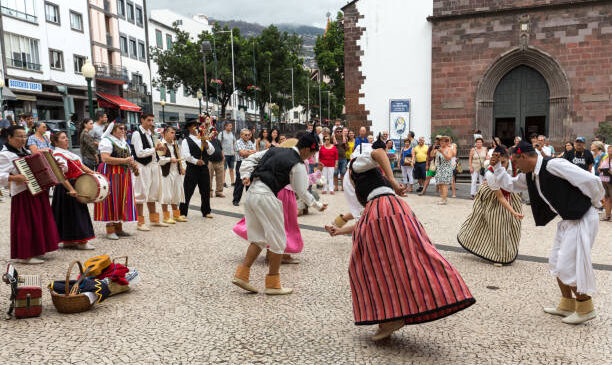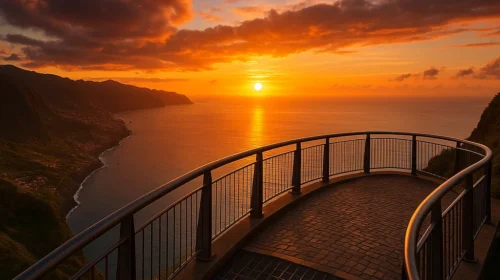Bailinho da Madeira – The Heartbeat of Madeiran Folklore
The Bailinho da Madeira is arguably the most emblematic dance of Madeira, capturing the island’s cultural spirit, joy, and community essence.
Often referred to as “the little dance of Madeira,” it is a vivid expression of local traditions, blending rhythm, movement, music, and storytelling into a spectacle that enchants both locals and tourists alike.
Unlike staged performances that can feel distant or formal, the Bailinho is immersive, participatory, and celebratory, offering a glimpse into Madeira’s soul through every footstep and musical note.
It is not simply a dance for entertainment; the Bailinho da Madeira embodies centuries of history, rural heritage, and communal identity. Each performance connects the present to the past, allowing Madeira’s culture to thrive in an era of modernity while keeping traditions alive for future generations.
Historical Roots and Evolution
The Bailinho da Madeira originated in the 19th century, emerging from rural festivals, harvest celebrations, and village gatherings. In a time when the island’s economy relied heavily on agriculture, farmers and villagers would come together to celebrate religious festivals, seasonal events, or successful harvests.
Music and dance were natural forms of expression, creating a fusion of rhythm and storytelling that would gradually evolve into a distinct folk tradition.
The dance was influenced by European folk dances brought by settlers, but over time, Madeira’s communities adapted these influences into something uniquely island-based.
The Bailinho’s rhythm and movements reflect Madeira’s landscapes, the vitality of its people, and the playful interactions that typified rural life. Originally, it served not just as entertainment but also as a social platform for courtship, where young men and women could interact under the guidance of tradition and custom.
Instruments and Music
At the core of the Bailinho da Madeira is its music, a lively and infectious accompaniment that drives every movement.
The music is produced using traditional instruments, many of which are unique to Madeira:
- Rajão and Machete: These small stringed instruments are similar to ukuleles and provide melodic, cheerful tones that give the Bailinho its signature rhythm.
- Accordion: Often the harmonic backbone of the music, the accordion adds depth, drive, and melody to the performance.
- Flute: Light and playful, the flute adds embellishments that mimic the natural sounds of Madeira, such as birdsong or wind through the mountains.
- Brinquinho: Perhaps the most iconic instrument associated with the Bailinho, the Brinquinho is a small percussion device featuring miniature wooden figures with ruffled skirts that move when shaken. It produces a unique percussive rhythm, adding whimsy, fun, and a visual element that delights audiences of all ages.

The combination of these instruments produces a soundscape that is irresistible, lively, and celebratory. It is almost impossible not to tap one’s feet or clap along, as the music invites everyone, locals and visitors alike, to participate in the joyous energy of the dance.
Dance Steps and Costume
The Bailinho is fast-paced, energetic, and intricate, marked by synchronized footwork, spins, and hand gestures. Typically performed in pairs, dancers often engage in playful movements that resemble courtship, storytelling, or even mimic everyday life. Steps are usually small but rapid, emphasizing agility and coordination.
Clapping, stamping, and turns punctuate the rhythm, creating a visual spectacle that complements the lively music.
Costumes are an essential part of the Bailinho da Madeira, adding color, tradition, and authenticity to the performance. Men traditionally wear embroidered waistcoats, white shirts, and hats, while women don vibrant skirts, aprons, blouses, and headscarves.
The costumes not only enhance the visual impact of the dance but also preserve elements of historical rural fashion, connecting modern audiences to the island’s cultural roots.
Festivals and Where to Experience the Bailinho
For anyone visiting Madeira, witnessing the Bailinho da Madeira is a cultural highlight. Performances occur at festivals, fairs, cultural centers, and even in village squares.
Some of the best opportunities include:
- Madeira Folklore Festival: Held in Funchal, this is one of the island’s largest cultural events. Folk groups from across Madeira perform the Bailinho in full costume, showcasing traditional music, instruments, and choreography. It is a grand celebration of Madeiran heritage, ideal for tourists seeking a complete folkloric experience.
- São João Festival: Celebrated in Funchal, Câmara de Lobos, and Santana, the midsummer festivities feature outdoor Bailinho performances accompanied by fireworks, music, and local cuisine. The dance becomes part of a communal celebration that blends tradition with festivity.
- Village Fairs and Local Festivals: Many villages host smaller, intimate events where locals perform the Bailinho for community gatherings. Watching the dance in this context offers a more authentic and immersive experience, allowing tourists to witness the dance in its natural cultural environment.
- Cultural Centers and Museums: Institutions like the Madeira Story Centre or local folklore museums often hold Bailinho demonstrations, combining education with performance. Visitors can learn about the instruments, the history, and even try the dance themselves under the guidance of professionals.
Many of these performances are interactive. Tourists are often encouraged to clap, stamp, and even join in the dance, creating a connection with the local culture that is both fun and memorable.

Stories, Myths, and Curiosities
The Bailinho da Madeira is rich in storytelling, humor, and symbolism:
- Some sequences mimic daily tasks, rural activities, or playful interactions between villagers, turning the dance into a living narrative.
- Courtship and social interactions are subtly depicted, with men and women using steps and gestures to express interest while adhering to traditional social norms.
- The Brinquinho adds a whimsical touch, with miniature figures “dancing” in rhythm, captivating audiences and adding a playful visual dimension.
- Different villages have their own variations of the dance, creating regional distinctions while maintaining the core rhythm and style.
- Watching or learning the Bailinho provides insights into Madeira’s history, social structure, and rural life, offering more than entertainment—it is an educational and cultural journey.
Modern Significance and Community
The Bailinho da Madeira is more than folklore; it is a symbol of community and identity. For locals, it fosters a sense of pride, preserves generational knowledge, and strengthens communal ties. For tourists, it provides a window into the island’s living culture, offering a participatory experience that transcends ordinary sightseeing.
The dance also serves as a cultural bridge, connecting generations. Young performers learn from elders, ensuring that the tradition continues while also adapting to contemporary contexts. This living heritage highlights Madeira’s resilience and the importance of maintaining cultural identity in a globalized world.
Experiencing the Bailinho Today
Tourists seeking to experience the Bailinho da Madeira have multiple options. Apart from festivals and village fairs, several tourism-oriented experiences provide hands-on learning. Visitors can join workshops, practice basic steps, and even perform alongside local dancers. This interactive approach allows tourists to feel the rhythm, understand the music, and appreciate the skill and tradition behind each step.
Additionally, many performances are complemented by local gastronomy, music shows, and artisan markets, creating a multi-sensory cultural experience. Watching the Bailinho with live music, colorful costumes, and festive atmosphere is an experience that engages the eyes, ears, and feet, leaving a lasting impression of Madeira’s cultural richness.
Fun Facts
- The Bailinho is sometimes called the “dance of little steps” because of its quick, intricate footwork.
- The Brinquinho’s moving figures are considered a cultural icon of Madeira and are often sold as souvenirs.
- Each dance performance is unique, reflecting the personality and interpretation of the performers.
- The dance often incorporates humor, improvisation, and storytelling, making it as entertaining as it is culturally significant.
Conclusion
The Bailinho da Madeira is a living tradition, a cultural emblem, and a joyful expression of island life. It is a celebration of music, dance, and community that has endured for centuries, adapting to modernity while preserving its historical essence.
Whether viewed in a festival, a cultural center, or a village square, the Bailinho invites participation, storytelling, and appreciation of Madeira’s vibrant heritage.
For tourists, experiencing the Bailinho is not simply about watching a performance—it is about immersing in the heart of Madeira, feeling its rhythms, engaging with its people, and carrying home a memory of an island where tradition and joy dance hand in hand.




